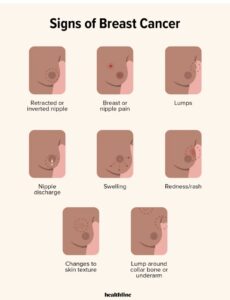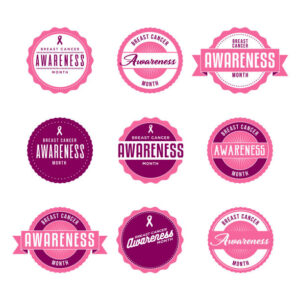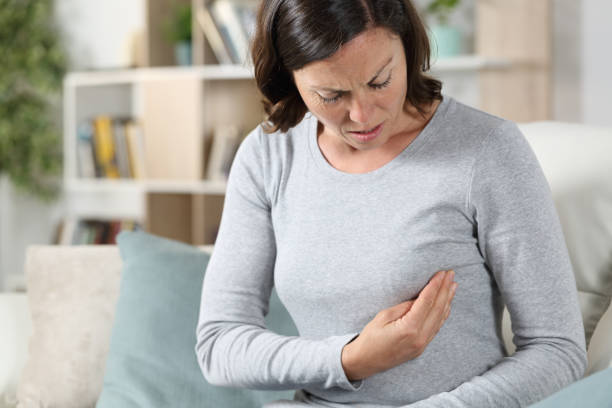Although there are often no indications of breast cancer in its early stages, early identification can change a breast cancer story into a survivor’s tale.
One of the first signs of breast cancer is a lump in the breast. However, for roughly a tenth of women with breast cancer, the lump isn’t even part of the wide range of symptoms.
Learn about the warning signs of breast cancer, what to expect next, and where to turn for help in this informative article.
Early breast cancer warning signs

Early signs of breast cancer
A monthly breast inspection or lingering mild atypical soreness can alert a person to a change in their breasts at an early stage. These are some of the early warning signals of breast cancer:
. Nipple morphology shifts
. Persistent breast soreness that does not ease up when your menstruation does.
. A lump that has recently appeared and is still there when your period arrives.
. Clear, red, brown, or yellow discharge from one breast duct.
. Changes to the breasts such as redness, swelling, skin irritation, itching, or a rash that have no apparent cause.
. A lump or bulge in the region of the shoulder or under the arm.
Cancer is more prone to develop in a mass that is firm and has irregular edges.
Later signs of breast cancer
Indicators that breast cancer has progressed include:
. The inward rotation of the nipple, also known as retraction.
. One breast augmentation
. Appearance of dimples on the breasts.
. Enlargement of an existing bump.
. Skin that has a “orange peel” texture.
. A lack of appetite.
. Accidental slimming down.
. A buildup of fluid and swelling in the armpit’s lymph nodes.
. Abnormally prominent veins in the bust.
Just because you’re experiencing some of these signs doesn’t indicate you definitely have breast cancer. For instance, a snotty nose could be the result of an infection. If you are experiencing any of these symptoms, you should schedule an appointment with your doctor for a thorough examination.
What is a “normal” breast?

In case you hadn’t guessed, there is no such thing as a “normal” breast. The size and shape of a woman’s breasts can vary greatly. When we say “normal,” we refer to what is typical in your culture. The normal appearance and sensation of your breasts, as well as the possible consequences of any modifications.
It’s important to remember that alterations in breast size and shape are a common symptom of ovulation. Possible causes for this include fluid retention:
. swelling
. pain, ache
. pain
. lumpiness
After you start your period, these signs should go away.
Breast self-checks

Performing self-examinations on a regular basis can help you become familiar with your breasts’ natural appearance and texture, allowing you to spot changes quickly. So, what should you be on the lookout for:
. Difference in overall size, shape, or color of your breasts.
. Dimpling or bulging of the skin.
. Redness, discomfort, rash, or swelling.
. Abnormal discharge; inverted nipple.
How to perform a breast self-check
1. Face a mirror and stand tall, arms resting on your hips. You should check your breasts out visually.
2. Do it again, but this time raise your arms.
3. Relax and lay on your back to examine your breasts.
Start by feeling your left breast with your right hand. Move your fingers around in a circular manner, tapping with the pads of your fingers to feel for any lumps or other abnormalities. Make sure the entire breast is hidden, from the bust to the underarm, and from the waist to the neck.
4. Check your right breast with your left hand again, and so on.
5. Do the exercise in either a standing or seated position. To accomplish this, you may use the shower as a convenient workspace.
Are breast lumps typically cancerous?
Most breast lumps aren’t cancerous, despite the stigma that surrounds them. In fact, benign breast illness is the result of around 75% of breast biopsies.
The following are typical benign breast lump triggers:
infected breasts.
breast lumps caused by fibrocystic disease.
fibroadenoma (noncancerous tumor)
necrosis of fat (damaged tissue)
Without a biopsiy, a tumor caused by fat necrosis cannot be separated from a malignant lump.
Breast cancer is most often identified by the development of a new, painless lump in the breast.
Other causes of breast pain and tenderness
When people experience soreness or pain in their breast, they may immediately worry that they have cancer. However, discomfort in the breasts is not usually the initial sign of breast cancer. There are many additional potential sources of discomfort.
Breast discomfort, also known as mastalgia in the medical community, can be brought on by a number of different conditions:
. Changes in hormone levels that occur during menstruation.
. A few medications to prevent pregnancy.
. Remedies for conceiving.
. A poorly fitting bra that doesn’t support the breasts.
. Cysts in the breasts, if you will.
. Having enormous breasts, which can cause discomfort in the shoulders, neck, and back.
. Stress.
Types of breast cancer

Breast cancer is divided into two broad classes:
. Cancer that stays put (in situ) is cancer that has not yet metastasized to other parts of the body. This is the initial phase, or stage 0.
. Cancer that spreads across organs and tissues by invading them tumors that have metastasized to nearby organs. Depending on how far it has spread, we classify them as either stage 1, 2, 3, or 4.
Male breast cancer
Those who are biologically male at birth have a lower risk of developing breast cancer. While older men are at a higher risk for developing male breast cancer, the disease can strike at any age.
Some people may not know that their own breast cells have the potential to become malignant. The prevalence of breast cancer is lower in men than in women because male breast cells are not as fully formed as female breast cells.
Having a lump in the breast is the most noticeable indicator of breast cancer in those who were conceived as male at birth. Besides the presence of a lump, other indicators of male breast cancer are:
. A physical alteration characterized by an augmentation of the breast tissue.
. Emptying one’s nipple.
. Inflammation and/or flaking of the nose.
. An inwardly-curving or retracting nipple.
. Changes to the breasts such as redness, swelling, skin irritation, itching, or a rash that have no apparent cause.
. lymph nodes under the arm swell.
Since men may not routinely check for lumps in their breast tissue, the disease is generally identified at a more advanced stage in males.
Diagnosing breast cancer
When a patient complains of breast pain, soreness, or a lump to their doctor, they may order one or more of several standard diagnostic procedures.
Physical examination
Your doctor will check for nipple issues and breast discharge as well as inspect your breasts and breast skin. Additionally, they may feel your breasts and underarms for lumps.
Medical history
Your doctor will inquire as to your personal medical history, current prescriptions, and the health of your family members.
Tell your doctor if anyone in your family has ever been diagnosed with breast cancer. Breast cancer has been linked to genetics. Additionally, your doctor will inquire as to when you first observed these symptoms.
Mammogram
A mammography, or breast X-ray, may be recommended by your doctor to determine whether or not a lump is cancerous.
Ultrasound
Imaging breast tissue using ultrasonic sound waves is possible.
MRI
In addition to other diagnostic procedures, your doctor may recommend an MRI. This imaging method is also used to check up on breast tissue without doing any harm.
Biopsy
Extracting a sample of breast tissue for diagnostic purposes. As of now, this is the only surefire means to verify a breast cancer diagnosis.






